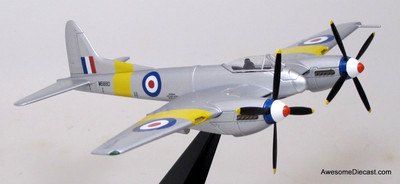Oxford Diecast
Oxford Diecast 1:72 Grumman Hellcat F6F-5 Lt.Cdr.Willard E. Eder. US Navy 1945

Oxford Diecast 1:72 Grumman Hellcat F6F-5 Lt.Cdr.Willard E. Eder. US Navy 1945
$29.95
The Grumman F6F Hellcat was a carrier-based World War Two fighter aircraft. It was developed to supersede the F4F Wildcat but also to take on the Japanese Mitsubishi A6M Zero. It took its first flight in June 1942 and was fully operational the following year and would become arguably the US Navy’s most successful fighter particularly in the second half of the War in the Pacific. Development refinements gave it an edge over its immediate competitor the Vought F4V Corsair, establishing itself as a rugged, well-designed carrier fighter, resulting in air superiority over the Japanese in that particular theatre of war.
During service with the US Navy. US Marine Corps and the Royal Navy FAA, the Hellcat was credited with destroying over 5,200 enemy aircraft, more than any other Allied naval aircraft.
The 1:72 scale Oxford model of Lt Cdr William E Eder’s F6F refers to their period of service in the VS-1 Squadron – a carrier-based Scouting Squadron in 1945. Leading up to that point, he had already had an illustrious career. He had entered naval flight training and got his wings in 1940 and was immediately assigned to naval air squadron, where he served for the next two years. During this time, William Eder received his DFC for action in the Battle of Bougainville. He then took part in the Battle of the Coral Sea, earning the Navy Cross. Deployed from the Pacific to the Atlantic in August 1942, he served with FS 29 where he learned everything from gunnery to operations executive officer amd on to commanding officer. He accepted a commission into the regular Navy in 1943 and moved to Atlantic duties. For his action in supporting the occupation of Morocco, William Eder was awarded the Silver Star. Moving forward to Lt Cdr Eder’s leadership of 29 FS Squadron aboard aircraft carrier USS Cabot, between October 1944 and April 1945 – the longest extensive combat in history - they shot down 112 enemy aircraft, including further successes by Lt Cdr Eder, cementing his well-earned ‘Ace’ status at the end of the conflict. William ‘Bill’ Ernest Eder survived well into his 80s, dying in California in 2009.
Celebrating his achievements, our Grumman Hellcat is decorated in the midnight blue camouflage scheme with white graphics including the White Star on the fuselage, wing and underwing, with Lt Cdr Eder’s VS-1 squadron markings on the tail fin. The gun barrels and instrument panel are both black and the cockpit interior is moulded dark green. Exhaust pipes, wheels and tyres are all black while the wheel hubs and pitot tubes are silver. The propellers feature blue spinners with yellow tips. Like any WWII Ace, pilots were used to adding their tallies on the side of the fuselage. If you look closely beneath the cockpit window, you will see the bombs indicating the Luftwaffe ‘kills’ illustrated by a black Swastika and next to them there is a series of Japanese flags, depicting the number of Kills from the Pacific campaigns too. The model encapsulates an incredible wartime career echoed in an authentic and evocative tribute.


















